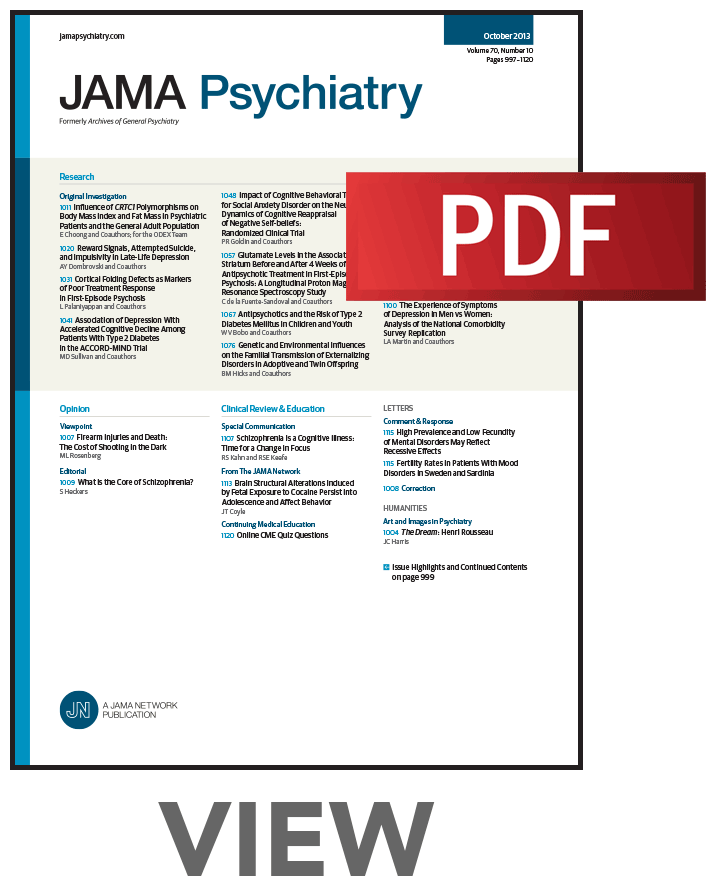Progression of Transdiagnostic Stages From Childhood to Young Adulthood.
IF 17.1
1区 医学
Q1 PSYCHIATRY
引用次数: 0
Abstract
Importance Transdiagnostic clinical staging models for mental disorders are receiving increased attention. However, their underlying assumptions are underresearched; for example, it is not clear whether the observed progression across stages occurs independently of preexisting risk factors. Objectives To test the likelihood of progression from stage 0 (familial risk) in childhood to stage 1a (mild symptoms) in adolescence and subsequently to stage 1b (clinically significant symptoms) in young adulthood, accounting for confounders, and to explore potential mediators. Design, Setting, and Participants This prospective cohort study included participants from the Avon Longitudinal Study of Parents and Children (ALSPAC). ALSPAC included pregnant women and their offspring residing in Avon, United Kingdom, between 1991 and 1992, with a proportion of offspring followed up into young adulthood. Eligible participants provided data on stage determinants and potential confounders from birth until age 24 years. Data were collected from 1991 to 2015 and analyzed from January 2002 to June 2025. Exposures Exposures were clinical stages 0 and 1a in separate tests of association with stages 1a and 1b, respectively. Criteria for stage 0 were the presence of schizophrenia or severe depression in a first-degree relative. Criteria for stage 1a were the presence of 1 to 2 symptoms of depression, anxiety, or psychosis at ages 12 to 13 years. Main Outcomes and Measures Outcomes were stage 1a in adolescence and stage 1b in young adulthood. Criteria for stage 1b were at least moderate symptoms of depression, anxiety, or psychosis, with associated functional impact at ages 18 to 24 years. Confounders were sex assigned at birth, obstetric risk, parental social class, ethnicity, family adversity, temperament, early life events, and neurocognition, measured in childhood. Results Among those with complete data at all 3 time points (1375 participants; weighted, 7342), 796 participants (57.9%; weighted, 51.5%) were female and 579 (42.1%; weighted, 48.5%) were male. After adjusting for potential confounders, there was an association between stage 0 in childhood and stage 1a in adolescence (3860 participants; weighted, 7388 participants; odds ratio [OR], 1.65, 95% CI, 1.30-2.11) and between stage 1a in adolescence and stage 1b in young adulthood (1661 participants; weighted, 7466 participants; OR, 2.07; 95% CI, 1.07-4.01). Level of neuroticism in adolescence mediated 18% of the association between stage 1a in adolescence and stage 1b in young adulthood. Conclusions and Relevance In this cohort study, young people with mental health problems meeting criteria for early clinical stages were at heightened risk of developing subsequent stages, independent of early life risk factors. This study supports the assumption of progression underlying clinical staging models for mental disorders.儿童期到青年期的跨诊断阶段进展。
精神障碍的跨诊断临床分期模型正受到越来越多的关注。然而,他们的基本假设尚未得到充分研究;例如,尚不清楚观察到的分期进展是否独立于先前存在的危险因素。目的:在考虑混杂因素的情况下,检验从儿童期0期(家族性风险)发展到青春期1a期(轻度症状)并随后发展到青年期1b期(临床显著症状)的可能性,并探索潜在的介质。设计、环境和参与者本前瞻性队列研究包括来自雅芳父母和儿童纵向研究(ALSPAC)的参与者。ALSPAC包括1991年至1992年期间居住在联合王国埃文的孕妇及其后代,其中一部分后代被随访至青年期。符合条件的参与者提供了从出生到24岁的阶段决定因素和潜在混杂因素的数据。数据收集于1991年至2015年,分析时间为2002年1月至2025年6月。在与1a和1b阶段相关的单独试验中,暴露分别为临床0期和1a期。0期的标准是一级亲属中存在精神分裂症或严重抑郁症。1a期的标准是在12至13岁时出现1至2种抑郁、焦虑或精神病症状。主要结局和测量结果为青春期1a期和青年期1b期。1b期的标准是18 - 24岁时至少有中度抑郁、焦虑或精神病症状,并伴有相关的功能影响。混杂因素包括出生时的性别、产科风险、父母的社会阶层、种族、家庭逆境、气质、早期生活事件和儿童时期的神经认知。结果3个时间点数据完整的1375人(加权7342人)中,女性796人(加权57.9%,51.5%),男性579人(加权42.1%,48.5%)。在调整了潜在的混杂因素后,儿童期0阶段和青春期1a阶段之间存在关联(3860名参与者;加权,7388名参与者;比值比[OR], 1.65, 95% CI, 1.30-2.11),青春期1a阶段和青年期1b阶段之间存在关联(1661名参与者;加权,7466名参与者;OR, 2.07; 95% CI, 1.07-4.01)。青春期神经质水平介导了青春期1a阶段和青年期1b阶段之间18%的关联。结论和相关性在这项队列研究中,符合早期临床阶段标准的青少年心理健康问题发展为后续阶段的风险较高,独立于早期生活风险因素。这项研究支持了精神障碍临床分期模型的进展假设。
本文章由计算机程序翻译,如有差异,请以英文原文为准。
求助全文
约1分钟内获得全文
求助全文
来源期刊

JAMA Psychiatry
PSYCHIATRY-
CiteScore
30.60
自引率
1.90%
发文量
233
期刊介绍:
JAMA Psychiatry is a global, peer-reviewed journal catering to clinicians, scholars, and research scientists in psychiatry, mental health, behavioral science, and related fields. The Archives of Neurology & Psychiatry originated in 1919, splitting into two journals in 1959: Archives of Neurology and Archives of General Psychiatry. In 2013, these evolved into JAMA Neurology and JAMA Psychiatry, respectively. JAMA Psychiatry is affiliated with the JAMA Network, a group of peer-reviewed medical and specialty publications.
 求助内容:
求助内容: 应助结果提醒方式:
应助结果提醒方式:


